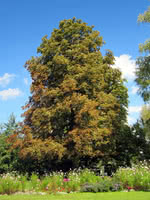Mon-Fri 9am - 5pm Mountain time
Horse Chestnut vs Mountain Maple
Aesculus hippocastanum
Acer spicatum
CUSTOM GROW
CUSTOM GROW
Horse Chestnut is a medium sized deciduous tree that is native to Greece but has been grown in North America for hundreds of years. It produces large nuts.
A top CO2 absorbing species. Experts think this tree may help climate change more than others.
Used to growing in the shadows of the damp forest, White Maple (aka Mountain Maple) is a great fit for shady and wet areas, such as beneath larger trees. Unlike most of its cousins, the White Maple is a shrub instead of a tree. It's still a maple, however, with sap that can be made into Maple syrup to prove it!
In May and June, the classic shapes of Maple leaves are joined by clusters of green and yellow flowers. Soon after, red samaras (aka helicopter seeds or whirligigs) appear. This distinctive appearance makes White Maple an excellent choice for giving urban yards a unique (and patriotic) look.
Horse Chestnut Quick Facts
Mountain Maple Quick Facts
Toxicity: most parts of plant are toxic

